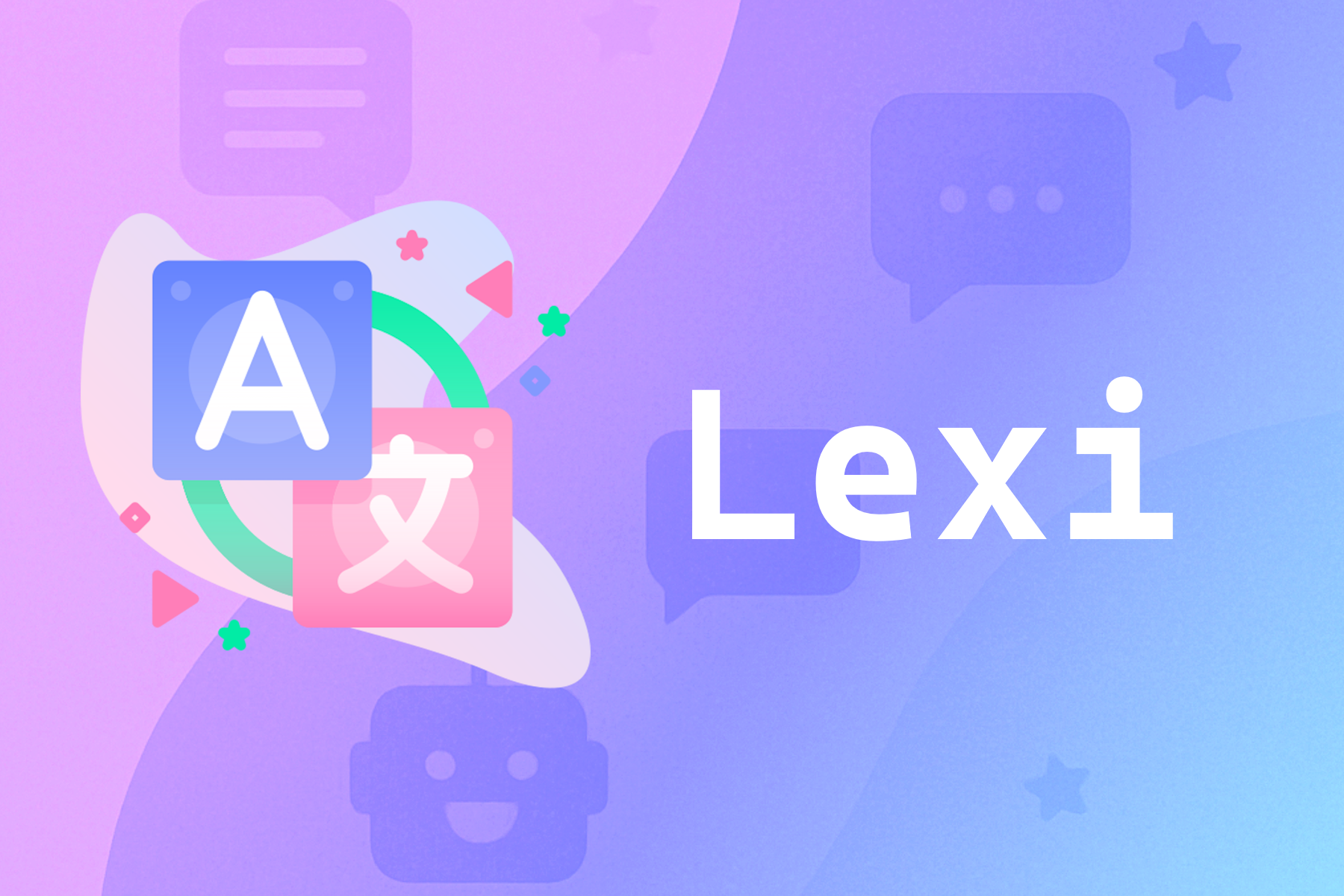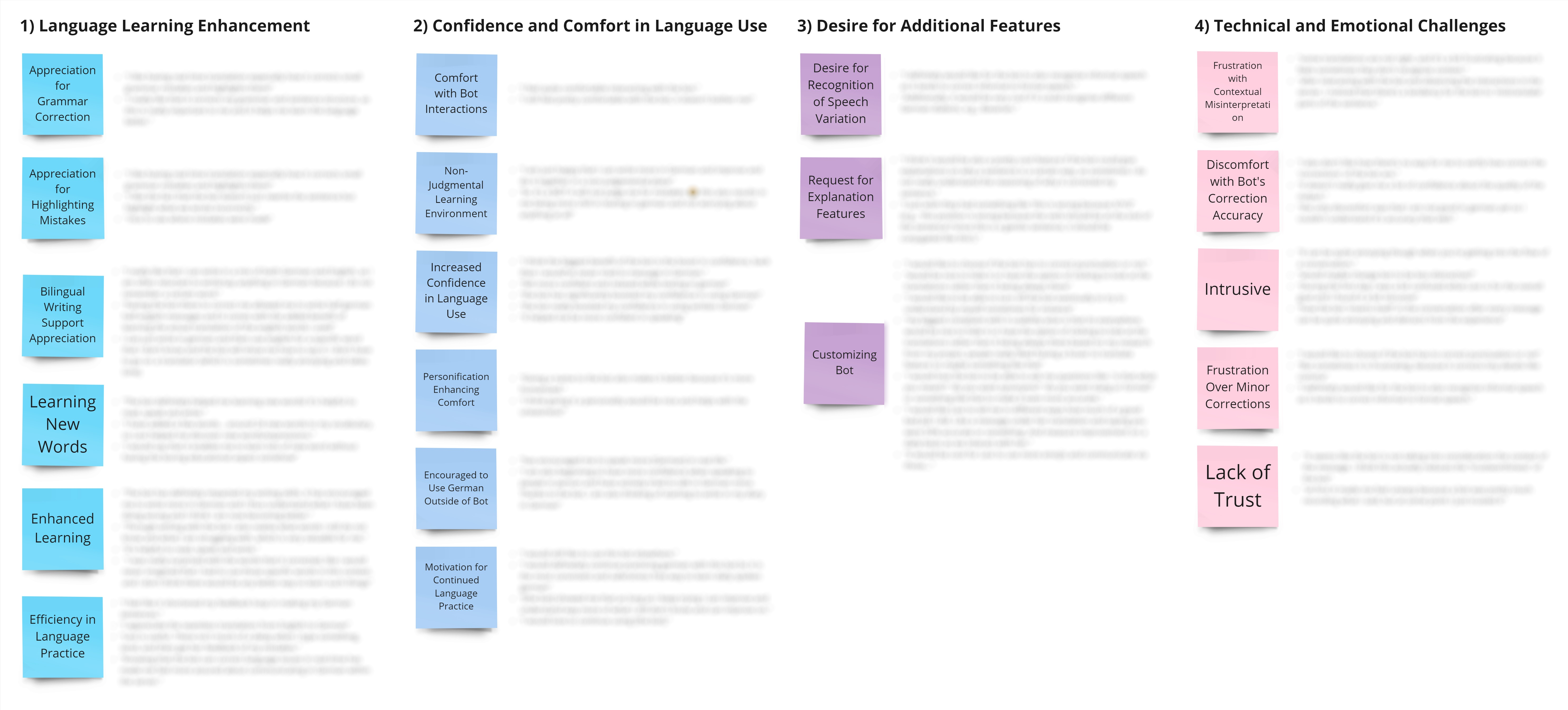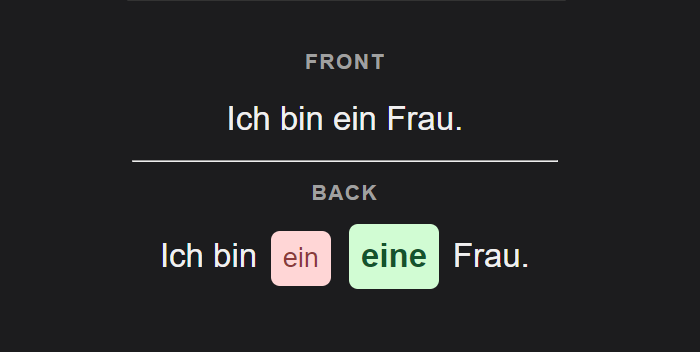
Duration: 10 weeks
My Roles: Solo designer, developer, and researcher

Duration: 10 weeks
My Roles: Solo designer, developer, and researcher
As part of my Advanced Contextual Interfaces course in the fall and winter of 2023/2024, I independently designed, developed, and evaluated a translation assistant bot named "Lexi" that provided corrective feedback to German learners during real-time conversations in a Discord server. Lexi acted as a technology probe—a simple, functional prototype intended to spark reflection and uncover design opportunities. Over the course of a week, participants chatted in a shared space and privately shared their thoughts in response to diary prompts I provided. Thematic analysis of these reflections gave me valuable insight into how Lexi was helpful and where it could be improved upon. After the course ended, I continued to develop Lexi further. Originally created as a lightweight prototype for a user study, it evolved into a fully AI-integrated learning assistant with GPT-5, expanding well beyond the original concept.
Feedback provided during conversational interaction facilitates foreign language acquisition [1], yet many language learners face challenges with receiving such feedback. Human tutors can be costly [2], and conversations with corrective AI alone may lack the fulfilling aspects of human-to-human interaction [3, 4, 5].

Early technology probe for Lexi (originally “Translator”), detecting and correcting a gender-article mismatch in German.
I developed a translation assistant bot named Lexi to explore how real-time corrective feedback influences language learning in live group conversations. Lexi is hosted on Google Cloud and runs within a shared Discord server. It uses the Google Translate API to detect whether a message is written in German or English. If a message is in German, it provides an English translation to help users verify their understanding and facilitate communication between each other, especially if they only know English, not German, well. It then returns a grammatically correct version of the original message, marking mistakes and oftentimes offering a more natural alternative. English messages are also translated into German, helping learners meaningfully acquire German by seeing how their own thoughts are expressed in the language.
While the version of Lexi shown above was used in the original study, I continued to refine and expand it after the course ended by adding new features and more advanced technologies. These enhancements are discussed later in the Post-Study Enhancements section.

Although Lexi worked as intended, the broader goal of the course was to investigate how tools like this can better respond to people’s needs in context. This setup served as a technology probe—a simple, functioning prototype designed to reveal insights through use [6]. To understand how learners experienced it in practice, I conducted a one-week diary study with nine German learners. While participants chatted in a shared Discord channel, Lexi provided corrections and translations in real time. They responded to diary prompts encouraging them to reflect on the bot’s functionality, their emotional responses, and how the feedback influenced their relationship with the language. With informed consent, Lexi was programmed to log these reflections in a structured CSV format to enable efficient analysis of response patterns.

An affinity diagram of the themes and codes determined by thematic analysis with censored participant quotes.
I conducted a thematic analysis of the diary entries, organizing reflections into a spreadsheet and later mapping them into an affinity diagram using Miro. This process helped surface recurring tensions, desires, and emotional reactions. Six out of nine participants submitted diary entries on multiple days, offering a valuable longitudinal view into how their perceptions evolved over time.
Many learners described Lexi as helpful and confidence-boosting. They appreciated receiving immediate feedback, especially for grammar and word choice. Some mentioned that seeing their mistakes corrected helped them better understand sentence structure and notice patterns in their writing. Lexi’s ability to handle messages that mixed German and English also made it easier for learners to participate without fear of making mistakes. Others mentioned that it removed the need to switch to external translators, making the learning process feel smoother. A few even reported feeling more motivated to write and speak German regularly outside of using the bot, noting improved comfort and reduced anxiety when using the language. Several participants shared that Lexi created a safer space to experiment with the language—especially compared to practicing with native speakers, where fear of judgment or embarrassment might otherwise hold them back.
Despite these benefits, several participants found Lexi intrusive at times, particularly when many people were chatting at once—some wished for the ability to temporarily hide feedback or choose when to see it. Additionally, a few participants wanted brief explanations to better understand Lexi's grammar corrections. Although I did not implement a full redesign during the course, this feedback informed how I refined Lexi afterward; in response to user feedback, I removed usernames from correction messages to reduce visual clutter, and I introduced an AI-powered explanation feature to improve support for language learning.
After the user study, I continued refining Lexi in my spare time—not just as a designer and developer, but also as a language learner. It quickly became my favorite way to practice writing in foreign languages: convenient, educational, and integrated into meaningful conversations with friends. I found myself naturally building on the insights from earlier participants while also addressing new needs that emerged through both personal use and shared interactions. Over time, Lexi became an essential part of my learning routine and one of the ways my friends and I stay close, share joy, and grow together across languages.
Key enhancements include:

Lexi translates an English message into German, Italian, and Japanese, demonstrating its multilingual capabilities.

Lexi corrects a grammatical error in a Spanish message.

Upon user request, Lexi sends an AI-generated explanation of a German mistake to a private channel.

A flashcard generated from Lexi’s correction, highlighting the user’s mistake in red and the correction in green to make feedback visually memorable.
This short video demonstrates how Lexi supports language practice—turning casual chats with friends into language-learning opportunities.
A detailed account of my research methods, data analysis, and design decisions made during the course can further be read here.
Additionally, a poster for this project can be viewed here.
This project gave me the opportunity to carry out a UX research and design process from start to finish entirely on my own—from building Lexi and structuring the study to analyzing data and imagining how the system might evolve. It strengthened my ability to work independently while staying grounded in user insight.
Key takeaways from the process include the following:
1. Opportunities for improvement often hide in soft but consistent feedback.
Small, repeated comments regarding chat clutter and unclear corrections did not seem urgent, but they signaled a deeper need. Addressing them led to simple yet meaningful improvements, like removing usernames and adding on-demand explanations. This encouraged me to pay closer attention to such small, recurring bits of feedback, even if they may not stand out right away.
2. Longitudinal feedback reveals telling insights that can be missed with short-term testing.
Reviewing diary entries over time revealed how users’ expectations and experiences with Lexi evolved. Some issues—like chat clutter—only became evident as group activity increased and corrections began to disrupt the conversation flow. Observing Lexi in such varied, real-world contexts helped me notice patterns that likely would have been missed in a one-off survey. This reminded me of the value of adapting designs as user needs and contexts shift.
3. Ambiguity is part of the process and worth embracing.
Working solo on this project meant leaning into uncertainty more than I was used to when making decisions. This taught me to become more comfortable with ambiguity, trust my judgment, and keep moving even when the path was not always clear.
